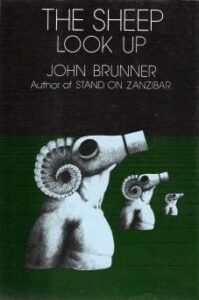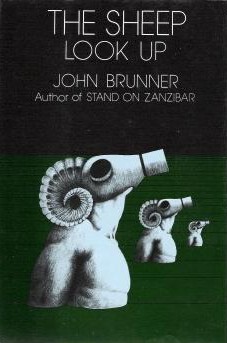In my recent mental wanderings in this blog, I’ve been exploring why, for those of us working for sustainability, it is crucial to take a long-term view, and I’ve been asking what it means to think about, plan for, and prioritize the future (e.g., “Deep Time“). I believe that our failure to do so and to seriously tackle environmental crises often traces back, in one way or another, to a failure of imagination. In the area of climate change particularly, minds conditioned to political calculations are unable to imagine economic and diplomatic arrangements that would impel oil-producing countries like Nigeria, Canada, and Saudi Arabia to leave the rest of their reserves in the ground. Too many of our communities, societies, and governments are unable or unwilling to collectively imagine a world in which we forego the convenience of a car-based culture or voluntarily accept to raise carbon taxes to the point of behavior-changing pain.
If part of the problem is lack of imagination, then a critical piece of the solution presumably lies in making use of the most powerful tool for igniting the imagination: literature and the arts. And more than any other flavor of literature, the literature of the imagination is speculative fiction. Speculative fiction—including science fiction, fantasy, and horror—is built on a foundation of imagining worlds different from ours, worlds apocalyptically worse than ours, worlds wondrously more beautiful, more just, or more skilled than ours, and worlds that are neither better nor worse but that are different from ours, sometimes in subtle ways, sometimes in fundamental ways.
A brief aside on terminology
The various ways that people use the term speculative fiction can be confusing. Some people use it as a broad term that encompasses science fiction, fantasy, and horror. Others use it to refer to a genre that is its own category apart from those three. And yet others treat it as essentially synonymous with science fiction, but have reasons for preferring one term over the other.
So let me hedge my bets and just use the acronym SF, with the “S” meaning whatever you want it to mean.
The what-ifs of environmental SF
SF stories are built on what-if scenarios. This is the speculation in speculative fiction. In fantasy those what-ifs often relate to folklore, legends, magic, and imaginary creatures. In the sub-genre known as “hard science fiction”, those what-ifs often relate to advances in fields like astronomy, astrophysics, spaceflight, artificial intelligence, and robotics.
But the what-ifs in science fiction can just as easily be drawn from the environmental and biological sciences. When the speculation of an SF story is based on a field such as climatology, ecology, or wildlife biology, it does not necessarily mean the story is about climatology, ecology, or wildlife biology. Whether it speculates about magic and dragons, or AI and space colonization, or sea level rise and the destruction of ecosystems, the best SF literature is always about human beings.
For example, John Brunner’s novel The Sheep Look Up holds a mirror to the politics of our world, and projects it a few years into the future, presenting an ecological dystopia in which political leaders, corporations, and a mostly reactive and uncritical public have stood by while pollution and environmental destruction continued to the point of societal collapse. It tells the story of a diverse collection of people, each trying to survive in this dying world, and of the environmental disasters that bring them together. The details of the crises Brunner imagines are extreme, yet in some ways the 1972 novel is a prescient look at what our world has become.
Frank Herbert is best known for his Dune series, and rightly so, but other books of his deserve more attention than they get. His pair of novels, Whipping Star and The Dosadi Experiment are worth your time. Like Dune, one of the ideas they explore is the influence of the physical environment on culture and on a people’s collective psyche. They ask, “What if a human culture developed in an ecological hell?”
Or, if you’d rather read (or watch) something more hopeful, Kim Stanley Robinson’s Ministry for the Future or James Cameron’s Avatar movies are only the most famous recent examples.
Worldbuilding and the literature of the possible
My high school English teachers taught that any work of fiction is built upon four fundamental components. But of those four, setting always seemed to be the neglected step-sister of plot, character, and theme. The best SF, however, is different. In the best SF, setting is not simply a few descriptions here and there of a room or a landscape; in the best SF, setting is the outcome of deliberate worldbuilding, and the world that the author has imagined for us essentially becomes another character in the story. It becomes part of the what-if, the speculation at the heart of the story. What if sea level rises three meters? What if the biosphere becomes so damaged that it could no longer support human life? Or conversely, what if humans actually learned to live in harmony with nature?
SF is the literature of the possible. The possible worlds that it imagines are not always positive ones. But when they are positive, the result can be powerful, imagining what most of us are not ready to imagine. Click To TweetSF is the literature of the possible. The possible worlds that it imagines are not always positive ones. But when they are positive, the result can be powerful, imagining what most of us are not ready to imagine. Star Trek imagined a world in which nationalism, racism, and poverty had been left so far behind that its characters could barely conceive of them. Kim Stanley Robinson’s novels New York 2140 and Ministry of the Future imagine that as a human race we could actually take collective action to start getting ourselves out of the mess we’ve gotten ourselves into, and they even walk through some of the details of how we might do it.
When SF imagines positive futures, it does so not as a set of tedious policy proposals or as an abstract statement of principles. Instead, it brings that imagination to life through human stories. When SF is at its best, its imagination supercharges the imaginations of the people who read and watch it.
When the state of the world is dragging you down, and you have trouble finding the hope and the energy you need to take a long view, curl up with some good SF (especially if its environmental SF).
Post-script
As well as being an environmental social scientist, I also write SF. Visit my author web site to find out more—lancerobinsonwriter.com (and maybe even read one of my stories).


The problem is, one has to have some imagination to imagine new frontiers and imaginative scenarios. Where does imagination come from?.
There is a good prognosis for literature here (speculative fiction), but little on art.
I hope others will address ‘imagination’
I’m not suggesting that we should treat and think of speculative fiction primarily as some kind of policy tool. I didn’t talk much about the elusive something that makes art art, but it is important. When literature about social issues doesn’t have that elusive something, then chances are it’s just propaganda.
When speculative fiction is good, when it’s actually art, then igniting the imagination in ways that help us conceptualize sustainable, just futures is merely a positive side effect — a “co-benefit” as we say in the sustainable development field. I think ignition of the reader’s imagination around big social questions is a co-benefit we should take seriously, but it’s not the whole story. And what is the source of the writer’s imagination? Where does it come from? I don’t have a good answer for that. But maybe this quote from Ursula Le Guin (one of the great SF writers of the 20th century) explains why I’m struggling to find the words: